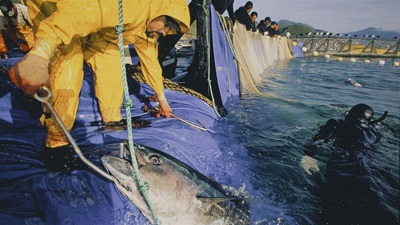Stalled Fisheries Management Threatens Sustainability of Eastern Pacific Tunas
Governments should use upcoming Panama meeting to reignite progress

A few months ago, governments in the Eastern Pacific region, building on years of promising discussions, were poised to adopt science-based, long-term management policies for Pacific bluefin and bigeye tunas – two species that face heavy fishing pressure. But earlier this summer, negotiations stalled, and now those governments might miss their last opportunity for the next year to make much-needed improvements in how they manage their shared fisheries.
So when the Inter-American Tropical Tuna Commission (IATTC), which oversees tuna fishing in the international waters of the Eastern Pacific Ocean, meets in Panama City, Panama, 1 to 5 September, it must recommit to modernizing management of its fisheries, which are worth over $5 billion annually.
Science-based management needed for valuable tunas
Pacific bluefin, prized by sushi lovers around the world, was on the brink of collapse because of overfishing and high catches of juveniles. But nearly a decade ago, fisheries managers from the IATTC and the Western and Central Pacific Fisheries Commission (WCPFC), which co-manages Pacific bluefin, began implementing a 20-year rebuilding plan that so far has recovered the population from 2 per cent of its unfished size to 20 per cent.
These early gains are commendable, but recovery is still fragile under the current management approach, because managers can still choose to raise quotas outside of scientific advice. And if they do that, the history of other fisheries shows that a backslide could happen fast.
Thus, it is critical that the IATTC adopt a long-term, science-based approach – a proven method called a management procedure (MP). Under an MP, Commission members agree in advance (pre-agree) on benchmarks to determine future changes in allowable catch. For example, if a fish population is healthy catch levels can stay the same or even increase over time. And if the population declines, limits will go down.
These procedures are successful in other international fisheries and eliminate the need to renegotiate rules when, for example, tuna numbers fluctuate significantly. By adopting a Pacific bluefin MP, the IATTC could help ensure long-term sustainability of the population.
Because Pacific bluefin is a highly migratory fish, it is managed by a joint working group that includes members from the IATTC and WCPFC – one factor that led to the current urgency. At their meeting in July, governments in the Eastern Pacific region failed to endorse an MP for adoption by the commissions.
But there is still time before the September IATTC meeting for working group members to put forward an MP for adoption this year. If the IATTC can agree to an MP in Panama City, the WCPFC could adopt the same measure at its annual meeting in December and help ensure that Pacific bluefin is well-managed throughout both sides of the Pacific Ocean.
The IATTC is similarly behind on finalizing an MP for bigeye tuna. The Commission can get back on track by providing sufficient funding and staff. In the meantime, IATTC members should do their part and adopt management objectives for bigeye that help define their goals, such as keeping the population stable. These advancements could set the stage for the IATTC to adopt a bigeye MP in 2026.
Expand port State measures to align with best practices
Even as the IATTC focuses on modernizing its fisheries management, it must also ensure that its members follow the rules. One way to do so is through strong controls at ports where fish are offloaded on their way to market.
Bad actors engaged in illegal, unregulated and unreported (IUU) fishing have long sought soft ports to move their ill-gotten catch. IUU fishing accounts for up to $23 billion worth of seafood annually around the world.
The IATTC adopted minimum standards for port inspections in 2021, but these measures are voluntary and fall short of the minimum standards outlined in the United Nations Food and Agriculture Organization (FAO) Port State Measures Agreement (PSMA). Fortunately, many other regional fisheries management organizations – including the General Fisheries Commission for the Mediterranean, North-East Atlantic Fisheries Commission, and Indian Ocean Tuna Commission – have adopted measures that adhere closely to the PSMA. It’s time for the IATTC and WCPFC to step up and do the same.
As a first step, the IATTC needs to make its existing port controls mandatory. With support from the FAO, the IATTC should also develop criteria for its members to exchange information on port activity – something the Commission could do easily by adopting the PSMA global information exchange system.
And the IATTC should deny port access to foreign vessels suspected of IUU fishing. The WCPFC can also strengthen its port State measures this year, and if both organizations act, they could attain significant improvements in governance throughout the Pacific Ocean this year and help ensure the legality of the tuna catch coming from the region.
IATTC members need to work with urgency for the remainder of this year to fulfill their mandates to manage tuna stocks sustainably and legally. Although the population gains for Pacific bluefin have been a remarkable achievement, without adopting an MP, managers risk backsliding to the old way of doing business and jeopardizing the stock’s recovery.
This September, the Commission must advance its work on MPs and update its port State measures to minimize the risk of IUU activity that could threaten the long-term sustainability of the region’s fisheries.
Dave Gershman works with The Pew Charitable Trusts’ international fisheries project.








